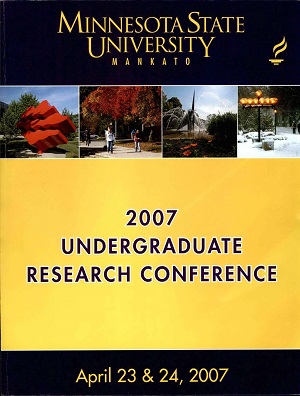ATV Fuels and Emissions Research
Location
CSU 202
Start Date
23-4-2007 3:00 PM
End Date
23-4-2007 5:00 PM
Student's Major
Automotive and Manufacturing Engineering Technology
Student's College
Science, Engineering and Technology
Mentor's Name
Gary Mead
Mentor's Department
Automotive and Manufacturing Engineering Technology
Mentor's College
Science, Engineering and Technology
Description
Our test vehicle (1987 Yamaha ATV) will be operated on a dynamometer to conduct emissions testing on an ATV while running through the European standardized drive cycle, ECE R-40. The drive cycle is currently used in the European Communities as a standard to test the output of emissions with various ATVs. This is a transient drive cycle (ATV is tested at various speeds and loads over time) that will be used for the emissions testing since there is not a drive cycle used in the United States that would work well with emissions testing of an ATV. Most small engine emissions testing in the United States is conducted on just the engine in a steady state, rather than the vehicle. With using this drive cycle, the data can be compared to the set standards of the ECE R-40. The California emissions bench (analyzes exhaust gas for pollutants) in the MNCAR lab will be used to test the emissions of the ATV. The emissions that will be tested are Carbon Monoxide (CO), Hydrocarbons (HC), Oxides of Nitrogen (NOx), and Carbon Dioxide (C02). To complete emissions testing on the ATV, the motorcycle dynamometer room had to be adapted to test ATVs. To do this a secondary roll was added on the side of the primary roll to accommodate two drive wheels. A platform was also added to the front of the secondary roll to provide an even surface for the four ATV wheels. The motorcycle/ATV dyno is an eddy current dynamometer, which means that it is able to simulate load on the ATV at various speeds. This will allow the emissions data to be successfully tabulated as if the ATV was running in normal driving conditions. The ATV will be operated on three different fuels during testing. The three different fuels will be regular gasoline, a mixture of 10% ethanol and 90% gasoline (ElO), and a mix of 20% ethanol and 80% gasoline (E20). Ethanol blended fuels will be used since Minnesota already requires 10% Ethanol in all fuels sold at the pump. That percentage of ethanol mandatory at the pump is going up to 20% by 2013. Drivability of the ATV will be monitored using hot and cold starts and the ATVs performance will be monitored during the drive cycle to note any negative effects that the fuel may have on the ATV.
ATV Fuels and Emissions Research
CSU 202
Our test vehicle (1987 Yamaha ATV) will be operated on a dynamometer to conduct emissions testing on an ATV while running through the European standardized drive cycle, ECE R-40. The drive cycle is currently used in the European Communities as a standard to test the output of emissions with various ATVs. This is a transient drive cycle (ATV is tested at various speeds and loads over time) that will be used for the emissions testing since there is not a drive cycle used in the United States that would work well with emissions testing of an ATV. Most small engine emissions testing in the United States is conducted on just the engine in a steady state, rather than the vehicle. With using this drive cycle, the data can be compared to the set standards of the ECE R-40. The California emissions bench (analyzes exhaust gas for pollutants) in the MNCAR lab will be used to test the emissions of the ATV. The emissions that will be tested are Carbon Monoxide (CO), Hydrocarbons (HC), Oxides of Nitrogen (NOx), and Carbon Dioxide (C02). To complete emissions testing on the ATV, the motorcycle dynamometer room had to be adapted to test ATVs. To do this a secondary roll was added on the side of the primary roll to accommodate two drive wheels. A platform was also added to the front of the secondary roll to provide an even surface for the four ATV wheels. The motorcycle/ATV dyno is an eddy current dynamometer, which means that it is able to simulate load on the ATV at various speeds. This will allow the emissions data to be successfully tabulated as if the ATV was running in normal driving conditions. The ATV will be operated on three different fuels during testing. The three different fuels will be regular gasoline, a mixture of 10% ethanol and 90% gasoline (ElO), and a mix of 20% ethanol and 80% gasoline (E20). Ethanol blended fuels will be used since Minnesota already requires 10% Ethanol in all fuels sold at the pump. That percentage of ethanol mandatory at the pump is going up to 20% by 2013. Drivability of the ATV will be monitored using hot and cold starts and the ATVs performance will be monitored during the drive cycle to note any negative effects that the fuel may have on the ATV.
Recommended Citation
Gostomczik, Kurt; Martin Mogensen; and Fredrick Anderson. "ATV Fuels and Emissions Research." Undergraduate Research Symposium, Mankato, MN, April 23, 2007.
https://cornerstone.lib.mnsu.edu/urs/2007/oral-session-08/3




